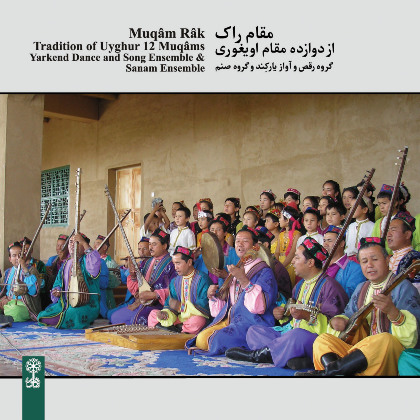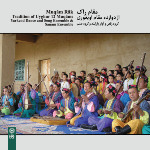- artist:Yarkend Dance and Song Ensemble & Sanam Ensemble
- release year:2007
- style(s):Traditional
- country:China
- formats:Audio File / Digital, CD (Compact Disc)
- record posted by:Mahoor Institute of Culture and Arts
- label:Mahoor Institute of Culture and Arts
- publisher:Mahoor Institute of Culture and Arts
- buy this record
A People of High culture
Belonging originally to the Hun race, Uyghurs are a large ancient nation among the eastern Turks. In the beginning, they inhabited lands of Mongolia and instituted their empire, and later, in the 9th century, occupied Sinkiang and settled there. For the time being, they principally live in this region that has come to be the broadest state of the People's Republic of China. Being a people whose origin is well substantiated through documents from the 5th century AD, Uyghurs are the first amongst the Turkish races to have as privileges a system of writing and a prominent culture. Hence, they fulfilled the role of the pioneers of civilization for other Turks. In the China's capital, in the age of Tang (the 7th century AD), there were at least eight musical ensembles from Turkistan including groups from Samarqand, Kâshgar, Turfan, Khotan, and Qomul. Buddhist murals in Kyzyl, in the vicinity of Kucha (c. 500 AD), depict musician gods or visions of paradise with such musical organs as the round long-necked Barbat with three strings, the pear-shaped Barbat with four strings, and also orchestras incorporating the angled harp , zither, Surnâ, transverse Nây, pan-flute, mouth organ, the hour-glass drum and diverse idiophones.
The Twelve Maqâms
Oniki Muqâm is the historical legacy of Uyghurs' music that is comprised of twelve movements (suites), in the twelve modes (Muqâms) in the Kâshghar and Yârkend traditions, each lasting about two hours. Name of each Maqâm refers to the Iranian-Arabic musical systems, though altogether their intervals are distinct from those of the regular Maqâms in the west of the Islamic world. These Maqâms are respectively Râk, Cheb bayât (Chap bayât), Chârigâh, Panjgâh, Ozhâl (Ozzâl), Ajam, Moshâverak, Oshshâq, Bayât, Navâ, Segâh, and Arâq. In the style of Kâshgar, actually the broadest of all styles, the whole repertoire encompasses 242 melodies sung on 1235 distiches. Moreover, they include 316 parts (Âhangs) too.



